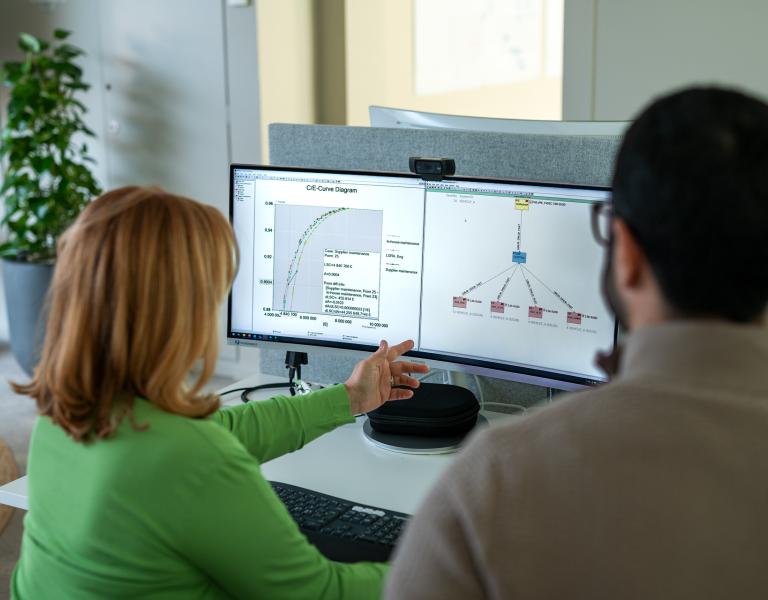
OPUS10 – Application Areas
OPUS10 is used by hundreds of organizations around the world, in a multitude of situations and application areas, – to optimize logistics support solutions as well as technical design - for systems ranging from fighter jets, submarines and radar systems to bullet trains, offshore rigs and telecom base stations.
In short, OPUS10 optimizes spare parts as well as entire maintenance and support solutions for maximized overall effectiveness at minimum life support cost. Spares optimization is the most well-known and wide spread application area for OPUS10, but continuous development has gradually expanded the scope and capabilities of the tool, making it unique in its ability to cater to optimization of the entire maintenance concept simultaneously.
OPUS10 is also ideal for analysis and objective side-by-side comparison of alternative system designs or support solutions, making it possible to identify the most cost effective solution.
Here is a description of some of the most common areas of application:
Spare Parts Optimization
Spare parts optimization is the most common application of OPUS10. Cutting edge applied mathematics is used to optimize assortment and allocation of spare parts, so that the highest possible performance can be achieved at the lowest possible cost. In addition to right-sizing an initial inventory, the tool will also calculate the optimal reallocation and/or replenishment of existing inventory. The flexibility of OPUS10 makes it possible to optimize components that are repairable, discardable or a mix thereof (i.e sometimes repaired, otherwise discarded), components with completely different resupply solutions, components with different criticality, and components with many different failure modes. Scenario models can include corrective and preventative maintenance, lateral support, time phased roll-out or phase-out of systems and multiple effectiveness targets that differ per location or system type.
Optimizing Logistic Support Organization and Resources
OPUS10 is the only software on the market capable of optimizing the complete maintenance concept, in parallel with the spare parts optimization, with a holistic systems perspective. This involves simultaneously making cost effectiveness trade-offs regarding:
- Which items to repair and which items to reorder
- Where in the organization it is optimal to repair each item, factoring in the impact this decision will have on investments in both repair resources and spare parts. (a capability referred to as LORA XT, meaning, Extended Location of Repair Analysis)
- Spares assortment and allocation
With OPUS10 it is also easy to compare alternative logistics support solutions with respect to cost efficiency. Because all relevant maintenance costs during the life cycle can be included in the OPUS10 model, different options can be evaluated both in terms of performance and total cost. This makes OPUS10 a powerful tool evaluating different logistics concepts. This could include deciding whether a centralized stock facility is better than several regional stocks, or whether transports of critical components should be carried out by truck (cheap, but longer lead time, necessitating larger inventory) or airplane (more expensive, but shorter lead time, necessitating smaller inventory).
In summary, OPUS10 facilitates proper cost-effective optimization of the logistic support organization, spares, personnel, and maintenance resources, all from a holistic perspective.
Optimizing System Design
As with logistic support solutions listed above, it is easy to compare different system configurations to decide which is the most effective overall. With OPUS10, different design decisions can be evaluated in terms of their impact on maintenance needs, system performance life investments and support costs. One example of this would be using OPUS10 to decide whether it is is it more cost effective to select an expensive component with a low failure rate, or if it is better to select a cheaper component with a high failure rate, assuming each component provides the same function.
LSC Analysis of Procurements and Development
When procuring, developing or preparing a proposal for a complex technical system and its logistics support solution, predictions and evaluations of the life support cost (LSC) are important parts of the analysis of its total life cycle cost (LCC), especially as operation and maintenance costs typically constitute 60-70% of the total cost of ownership for a system. Opus10 is ideal for bottom-up, engineering-driven estimates of LSC.
What If and Sensitivity Analysis
OPUS10 is ideal for analyzing how a certain solution is to data inaccuracy or potential changes to different criteria, and makes it possible to predict how the cost and efficiency of a solution are impacted, for instance, by:
- variations of +/-20% in failure rates
- a 10% increase of prices on spares
- an increase of 25% in the number of systems
- an decrease of operations by 25%
- variations of 30% in lead times
- the addition of a new maintenance contract
- a requirement for a minimum inventory level
- reduced repair times
- lateral support

Find out more about the decision support Opus Suite can provide to your organization.



